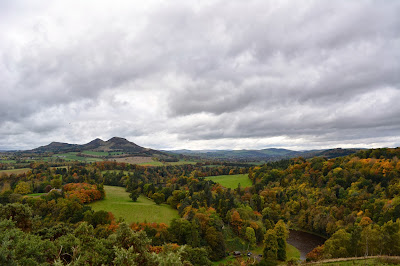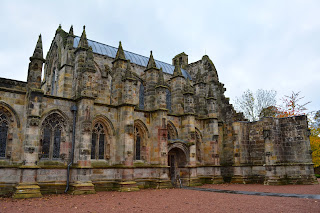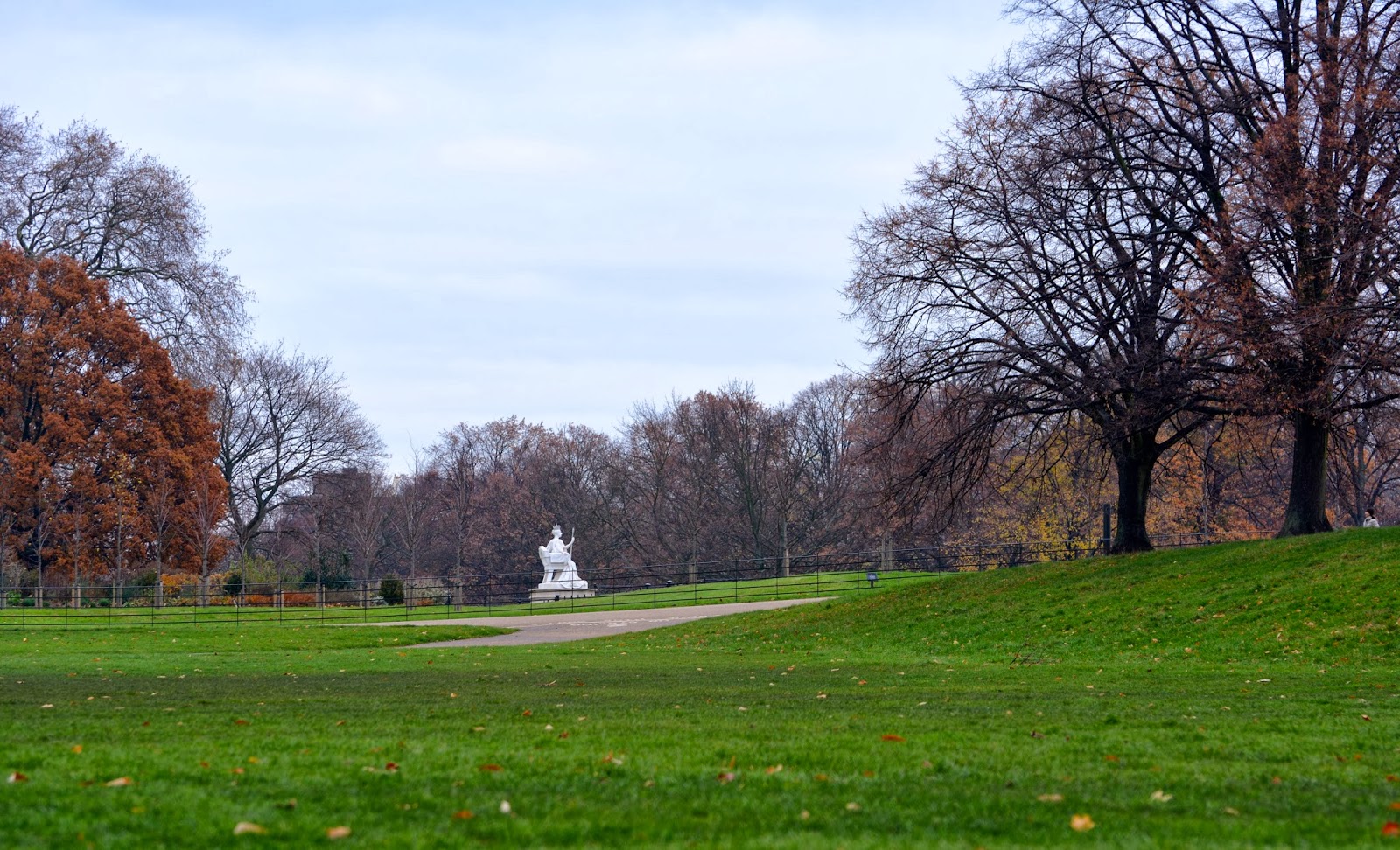The English/Scottish Borders
For my second day in Scotland I was off to the "Borders." The thing that was somewhat surprising to me about this was that a not insignificant part of the tour was actually back in England. Now I probably should have paid more attention to the "Borders Tour" name on the website, and I probably should have read more closely. Still, it did talk about the "Scottish Borders." Regardless, it was a great trip, with a lively guide who gave us an honest, legitimate, not always touristically propagandized version of Scottish history while still informing us about all the great details of legendary figure like Robert the Bruce.
The first stop was Rosslyn Chapel, a very, very old chapel built by one of the great landlords of the region, William Sinclair. Unfortunately, as such things go, he died before it was completed and then the family ran out of money. Thus, it is much smaller than the original ambitious plan, as some of the seemingly random outside walls demonstrate. It's been redeemed in modern times though, as a filming location for the Da Vinci Code. I'm going to have to go back and rematch the film to see if I can see it. Because it was under a big dome being dried out for around ten years, however, to allow it to be preserved, they had to use some fancy techniques. A scale model was built for exterior shots from above and around. A large wall was erected both outside and inside in order to allow Tom Hanks to walk toward it and then walk around inside it. Apparently a little relic was also added and painted on the wall, leaving a permanent stain, which the curators of course abhorred but now have tried to look on in a fond light.
 Melrose Abbey was the next destination, a gorgeous place but now largely in ruins. It really got me in the mood of the 19th century Romantic poets, though, I have to say. It was a pretty good place for photography but there were lots of people milling around so it was hard to get clear shots. Also marked was the burial place of the heard of Robert the Bruce, which was a pretty cool historical thing with which to come into contact. It was a brief but worthwhile stop before we headed off for the star attraction of the day: Alnwick Castle.
Melrose Abbey was the next destination, a gorgeous place but now largely in ruins. It really got me in the mood of the 19th century Romantic poets, though, I have to say. It was a pretty good place for photography but there were lots of people milling around so it was hard to get clear shots. Also marked was the burial place of the heard of Robert the Bruce, which was a pretty cool historical thing with which to come into contact. It was a brief but worthwhile stop before we headed off for the star attraction of the day: Alnwick Castle.
 I spent the beginning of my journey walking around the grounds, the ramparts on the walls, looking out over the sheep-dotted valley, and exploring some of the museums to various regiments that inhabited the castle in later times. There were lots of fun things to take pictures of and it was awesome to imagine being there when it was a fully functional fortress. There were lots of tourists but I think because of my own childhood connections there was something charming about seeing little children running wildly around with excitement. The autumn light, changing leaves, and general landscape of the Borders region definitely contributed to the experience, as well. It was a nice day (unlike the next one for my trip up to the Highlands). Even the color of the stone was reminiscent of my childhood imaginations.
I spent the beginning of my journey walking around the grounds, the ramparts on the walls, looking out over the sheep-dotted valley, and exploring some of the museums to various regiments that inhabited the castle in later times. There were lots of fun things to take pictures of and it was awesome to imagine being there when it was a fully functional fortress. There were lots of tourists but I think because of my own childhood connections there was something charming about seeing little children running wildly around with excitement. The autumn light, changing leaves, and general landscape of the Borders region definitely contributed to the experience, as well. It was a nice day (unlike the next one for my trip up to the Highlands). Even the color of the stone was reminiscent of my childhood imaginations.

 The Alnwick Castle Gardens were spectacular, especially in their fall colors. Unlike many locations, the fountains were still fully operational for my visit. This made it especially great. It's true that there were enough tourists to invest the experience with a sort of touristy vibe and make taking photos difficult. Still, I did find a few moments to repose on my own in grottos with burbling fountains. It would really be great to see the gardens in all sorts of different seasons, I'm sure. I could have spent more time here but we did have to go. I did get to tour each section, from the grand garden front and central with its fountains to the more French style garden at the top and to duck into the small gardens surrounding them as well as the more rolling field on one side. It was a splendid afternoon.
The Alnwick Castle Gardens were spectacular, especially in their fall colors. Unlike many locations, the fountains were still fully operational for my visit. This made it especially great. It's true that there were enough tourists to invest the experience with a sort of touristy vibe and make taking photos difficult. Still, I did find a few moments to repose on my own in grottos with burbling fountains. It would really be great to see the gardens in all sorts of different seasons, I'm sure. I could have spent more time here but we did have to go. I did get to tour each section, from the grand garden front and central with its fountains to the more French style garden at the top and to duck into the small gardens surrounding them as well as the more rolling field on one side. It was a splendid afternoon.
 Our final stop on the tour was a bit of a bonus that the guide throws in from his personal experience. Try as hard as I can I cannot find the name of this particular strand of beach. The access road out to the island is only accessible at low tide, otherwise, not unlike Mont Saint-Michel in France, the island is completely cut off from the mainland. We did not go out for this reason but he took us a bit of the way out onto the access road and let us get out. It was an eerie, calm, and beautiful atmosphere and also allowed us to see a taste of the ocean from Scotland. Of particular beauty was the abbey, jutting up ruggedly across the way.
Our final stop on the tour was a bit of a bonus that the guide throws in from his personal experience. Try as hard as I can I cannot find the name of this particular strand of beach. The access road out to the island is only accessible at low tide, otherwise, not unlike Mont Saint-Michel in France, the island is completely cut off from the mainland. We did not go out for this reason but he took us a bit of the way out onto the access road and let us get out. It was an eerie, calm, and beautiful atmosphere and also allowed us to see a taste of the ocean from Scotland. Of particular beauty was the abbey, jutting up ruggedly across the way.
The first stop was Rosslyn Chapel, a very, very old chapel built by one of the great landlords of the region, William Sinclair. Unfortunately, as such things go, he died before it was completed and then the family ran out of money. Thus, it is much smaller than the original ambitious plan, as some of the seemingly random outside walls demonstrate. It's been redeemed in modern times though, as a filming location for the Da Vinci Code. I'm going to have to go back and rematch the film to see if I can see it. Because it was under a big dome being dried out for around ten years, however, to allow it to be preserved, they had to use some fancy techniques. A scale model was built for exterior shots from above and around. A large wall was erected both outside and inside in order to allow Tom Hanks to walk toward it and then walk around inside it. Apparently a little relic was also added and painted on the wall, leaving a permanent stain, which the curators of course abhorred but now have tried to look on in a fond light.
 Melrose Abbey was the next destination, a gorgeous place but now largely in ruins. It really got me in the mood of the 19th century Romantic poets, though, I have to say. It was a pretty good place for photography but there were lots of people milling around so it was hard to get clear shots. Also marked was the burial place of the heard of Robert the Bruce, which was a pretty cool historical thing with which to come into contact. It was a brief but worthwhile stop before we headed off for the star attraction of the day: Alnwick Castle.
Melrose Abbey was the next destination, a gorgeous place but now largely in ruins. It really got me in the mood of the 19th century Romantic poets, though, I have to say. It was a pretty good place for photography but there were lots of people milling around so it was hard to get clear shots. Also marked was the burial place of the heard of Robert the Bruce, which was a pretty cool historical thing with which to come into contact. It was a brief but worthwhile stop before we headed off for the star attraction of the day: Alnwick Castle.
Alnwick Castle is a quite sizable and feels exactly as a castle should. As I've said elsewhere, it has been great to see in the United Kingdom castles of the sort I imagined since childhood, as much as I have enjoyed all the other types of castles and pseudo-castles I have seen elsewhere. Though Dover Castle and Edinburgh Castle definitely fit the bill, on some level Alnwick might perhaps have been the closest I've ever come to the sort of grand but functional fortress depicted, for instance, in Stephen Biestey's Castle.
 I spent the beginning of my journey walking around the grounds, the ramparts on the walls, looking out over the sheep-dotted valley, and exploring some of the museums to various regiments that inhabited the castle in later times. There were lots of fun things to take pictures of and it was awesome to imagine being there when it was a fully functional fortress. There were lots of tourists but I think because of my own childhood connections there was something charming about seeing little children running wildly around with excitement. The autumn light, changing leaves, and general landscape of the Borders region definitely contributed to the experience, as well. It was a nice day (unlike the next one for my trip up to the Highlands). Even the color of the stone was reminiscent of my childhood imaginations.
I spent the beginning of my journey walking around the grounds, the ramparts on the walls, looking out over the sheep-dotted valley, and exploring some of the museums to various regiments that inhabited the castle in later times. There were lots of fun things to take pictures of and it was awesome to imagine being there when it was a fully functional fortress. There were lots of tourists but I think because of my own childhood connections there was something charming about seeing little children running wildly around with excitement. The autumn light, changing leaves, and general landscape of the Borders region definitely contributed to the experience, as well. It was a nice day (unlike the next one for my trip up to the Highlands). Even the color of the stone was reminiscent of my childhood imaginations.
After touring the grounds extensively, I went into the keep. This was another element that I loved - the "castle" with the "keep" inside of it. Quintessential to my vision of what a castle is or "should be." Pictures weren't allowed in the keep but the rooms were spectacular. The library, in particular, was very impressive. There was also a foyer with a plethora of weapons lining every possible service of the walls. Though they have a lot of weapons in the Tower of London, this might have compressed the same number into this one room! It was interesting to learn that the Duke and his family still live in Alnwick Castle, at least part time. The elder daughter just got married (wedding pictures abounded), but the younger one is not yet - she looked about my age and I thought it might be worth seeking her out! Regardless, after my tour of the keep was finished, I still had enough time to visit the gardens.

 The Alnwick Castle Gardens were spectacular, especially in their fall colors. Unlike many locations, the fountains were still fully operational for my visit. This made it especially great. It's true that there were enough tourists to invest the experience with a sort of touristy vibe and make taking photos difficult. Still, I did find a few moments to repose on my own in grottos with burbling fountains. It would really be great to see the gardens in all sorts of different seasons, I'm sure. I could have spent more time here but we did have to go. I did get to tour each section, from the grand garden front and central with its fountains to the more French style garden at the top and to duck into the small gardens surrounding them as well as the more rolling field on one side. It was a splendid afternoon.
The Alnwick Castle Gardens were spectacular, especially in their fall colors. Unlike many locations, the fountains were still fully operational for my visit. This made it especially great. It's true that there were enough tourists to invest the experience with a sort of touristy vibe and make taking photos difficult. Still, I did find a few moments to repose on my own in grottos with burbling fountains. It would really be great to see the gardens in all sorts of different seasons, I'm sure. I could have spent more time here but we did have to go. I did get to tour each section, from the grand garden front and central with its fountains to the more French style garden at the top and to duck into the small gardens surrounding them as well as the more rolling field on one side. It was a splendid afternoon. Our final stop on the tour was a bit of a bonus that the guide throws in from his personal experience. Try as hard as I can I cannot find the name of this particular strand of beach. The access road out to the island is only accessible at low tide, otherwise, not unlike Mont Saint-Michel in France, the island is completely cut off from the mainland. We did not go out for this reason but he took us a bit of the way out onto the access road and let us get out. It was an eerie, calm, and beautiful atmosphere and also allowed us to see a taste of the ocean from Scotland. Of particular beauty was the abbey, jutting up ruggedly across the way.
Our final stop on the tour was a bit of a bonus that the guide throws in from his personal experience. Try as hard as I can I cannot find the name of this particular strand of beach. The access road out to the island is only accessible at low tide, otherwise, not unlike Mont Saint-Michel in France, the island is completely cut off from the mainland. We did not go out for this reason but he took us a bit of the way out onto the access road and let us get out. It was an eerie, calm, and beautiful atmosphere and also allowed us to see a taste of the ocean from Scotland. Of particular beauty was the abbey, jutting up ruggedly across the way.
Afterward - back to Scotland (with a brief stop to get photos by the signs!). A great day in an area half of which was unexpectedly in England. Still, I'm glad I did it and the guide gave me a lot of perspective on Scottish history while I got to see it firsthand.














Comments
Post a Comment